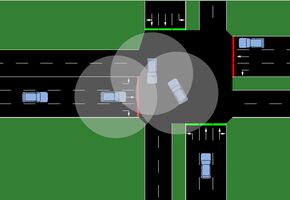
Design of adaptive V2V-Protocols for traffic performance improvement

Communication in Vehicular Ad-Hoc Networks (VANETs) is expected to improve road safety and traffic efficiency through the development of next generation road traffic applications. By recently signing the Memorandum of Understanding (MoU), European vehicle manufacturers have signalized their intention to bridge the gap from research to market by the deployment and integration of communication systems into cars from 2015 on. Vehicle-to-Vehicle (V2V) communication operating in the 5.9$ GHz frequency band pave the way for efficient and innovative road traffic applications which primarily help drivers in critical situations but could also improve traffic efficiency by providing real time information about road traffic conditions.
Cooperative V2V applications rely on the single-hop broadcast of status information shared among vehicles on a single channel. However, in high network load conditions caused by high vehicle densities and a fixed periodic message generation rate, the channel will suffer from severe channel congestion which subsequently leads to a deterioration of the communication performance reflected by packet collisions. The key challenge of V2V is to ensure the reliability of the communication in such a way that a cooperative awareness between nodes in direct neighbourhood can be achieved, especially at urban intersection which is characterized by the complex and rapid changing topology of vehicular networks due to varying node densities. Even if in the early stage of V2V deployment, only a low penetration rate - which a ratio of number of equipped vehicles with a communication system - could be achieved, traffic density can be expected to growth substantially in urban environments during peak hours. Moreover, road traffic congestion would negatively affect the network load caused by the increased number of nodes contenting the communication channel. Hence, congestion control methods are required to limit and control the load on the channel even in harsh radio propagation conditions so that each node would be able to detect and possibly communicate with surrounding vehicles and road side units present in its local neighbourhood.
To achieve this, dynamic and adaptive approaches are needed to ensure reliable environment independent communication. Especially for urban areas there are mechanisms which could improve communication performance and therefore traffic performance as a result of traffic efficiency applications. Even though many studies have been published in the past, there is still much place for improvement.
Researcher: Torsten Lorenzen, M.Sc.
Student Research Projects
2015
Kategorisierung und Bewertung von Staukontroll-Mechanismen zur Anwendung in der Fahrzeug-Fahrzeug-Kommunikation (Peter Lada)
Auswertung der Parametrierung eines Überlastkontroll-Algorithmus zur Anwendung in der Fahrzeug-Fahrzeug-Kommunikation (Shihua Zheng)